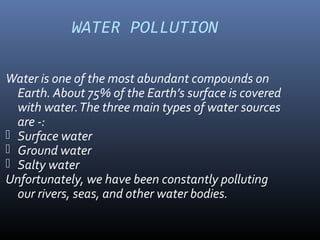Water pollution
- 1. WATER POLLUTION Water is one of the most abundant compounds on Earth. About 75% of the Earthâs surface is covered with water.The three main types of water sources are -: ï Surface water ï Ground water ï Salty water Unfortunately, we have been constantly polluting our rivers, seas, and other water bodies.
- 3. Causes of Water Pollution The main causes of water pollution are -: ï Discharge of untreated industrial and domestic sewage in to water bodies. ï Bathing animals, washing clothes, etc., in or near lakes, rivers, etc., dirties these water bodies. ï Oil leaks from ferry boats and ships leave a trail of oil on the water surface and pollute rivers and oceans. ï Inorganic pesticides and chemical fertilizers used by farmers drain into water bodies by a process called leaching. As a result, certain pesticides such as DDT can enter the bodies of aquatic animals and eventually reach human beings by the way of food chains.
- 4. Causes of Water Pollution
- 5. Effects of Water Pollution - 1 ï§ Industrial wastes discharged into the waters contain a lot of toxic substances that make water unfit for drinking and bathing. ï§ Untreated domestic sewage, when released into water bodies, becomes a breeding ground for a number of organisms that cause water-borne diseases. ï§ Oil spills are very harmful to aquatic animals, and lead to destruction of marine life. The cleaning up process also causes a lot of damage to marine habitat. ï§ Pollution of water also leads to a reduction in the number of aquatic plants and animals due to destruction of habitat and nesting places.
- 6. Effects of Water Pollution - 2 ï§ Ignition of arms and weapons releases large amounts of mercury. When water contaminated with mercury is used for drinking by animals and human beings, it causes numbness of limbs, lips, and tongue. It can also lead to blurred vision and mental disorders. ï§ The waste water released by factories and industries and the fertilizer-rich runoffs from agricultural fields is rich in organic matter. The process of washing away of fertilizers into water bodies is called leaching. The entry of nutrient- rich water results in a thick growth of algae, called algal bloom, and many other weeds. Soon these plants cover the entire surface of water. This is called eutrophication. The algae use up so much oxygen that the aquatic animals and other plants die due to lack of it.
- 7. Effects of Water Pollution
- 8. Prevention of Water Pollution Some steps to prevent water pollution are-: 1.) Bathing and washing clothes near water bodies such as lakes, ponds, and rivers should be avoided. 2.) Domestic and industrial sewage wastes should be treated to remove toxic substances before being released into water bodies. 3.) Pollution-control rules enforced by the government should be followed strictly. 4.) Use of eco-friendly fertilizers and herbicides should be encouraged.
- 9. Potable Water ï§ The water suitable for drinking by human beings is called potable water. To be considered fit for human consumption, a sample of water should ï§ Be transparent, colourless, and odourless; ï§ Contain sufficient amount of dissolved oxygen and salts; and ï§ Be free from harmful chemicals and microorganisms.
- 10. Potable Water
- 11. Purification of Water - 1 Water supplied in our homes generally comes from rivers and is contaminated with suspended impurities like sand, silt, and clay; soluble impurities like salts; and also microorganisms. Water, therefore, has to be cleaned in big purification plants before it reaches our homes. The three main processes that water undergoes during purification are sedimentation, filtration, and chlorination .
- 12. Purification of Water - 2 The various processes employed in purification of water are -: ï§ Water collected from river is made free of large pieces of dirt and pumped into reservoirs. ï§ Water is allowed to stand in large tanks so that suspended impurities settle down. This process is called sedimentation. ï§ Water is passed through filter beds to remove all other insoluble impurities. This process is called filtration. ï§ Water is chlorinated (by addition of chlorine) to kill any harmful microbes that may be present in at this stage. ï§ Water is supplied to homes and factories by huge water mains.
- 14. Various methods to purify water Filtration â The process of removal of insoluble impurities by passing impure water through a filter paper is called filtration. Sedimentation and decantation â In this method, impure water is allowed to stand undisturbed in a container, which allows insoluble impurities such as mud to settle to the bottom as sediments. This process is called sedimentation. Clean water can thereafter be transferred into a clean container by the process of decantation. Distillation â In this method, impure water is first heated to its boiling point to convert water into steam. The impurities are left behind in the container. The steam is then passed through a condenser, where it cools and changes back into liquid water.
- 15. Various methods to purify water
- 17. THANK YOU

















